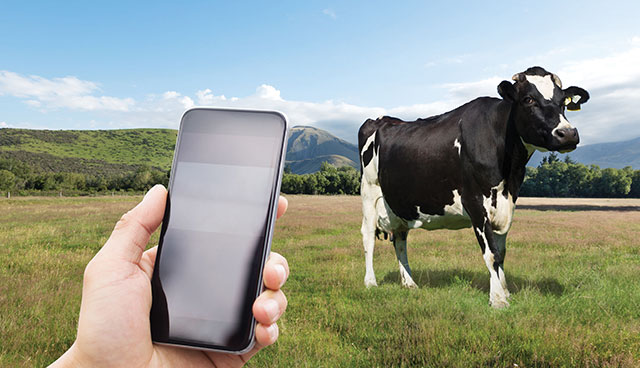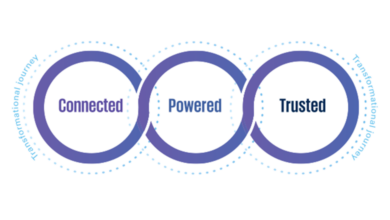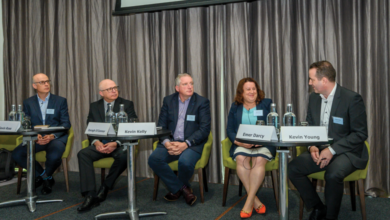New technologies driving agriculture


Change comes dropping slow. But, ever so gradually, new technologies are beginning to really enhance production efficiency of Irish agriculture. This revolution can be most clearly discerned where livestock farming is concerned. Richard Halleron speaks with Teagasc Director Gerry Boyle.
The era of robotic milking has arrived. There are currently around 220 units operating in the Republic with a similar number on-farm in the North. On almost all of these farms the decision to invest in a robot (approximately €135,000 per unit), was taken in order to reduce the drudgery and hard work associated with physically milking cows while, at the same time, giving those running the business more time to think strategically.
Temple Grandin, from the University of Colorado, is one of the world’s leading animal welfare specialists. She recently characterised the key benefit associated with robotic milking as that of giving farmers an opportunity to use the time that is freed-up in ways that will bring about the better management of their businesses as a whole.
Grandin takes it for granted that the robot is more than capable of physically milking cows efficiently time, after time, after time. As she is quick to emphasise, robots don’t get tired; they always carry out the milking process to a meticulously high standard and, for good measure, they represent a super highway of information where the performance of each, individual cow is concerned. Robots can also be programmed to dump milk from antibiotic-treated cows for the required period of time. In essence, they will act ensure that all withdrawal periods have been fully adhered to.
Currently, many dairy farmers prefer the option of putting the clusters on their cows manually. However, all research indicators indicate that in 20 years’ time, robotic milking will be the norm. But the development of new technologies is not solely a subject of interest for the livestock sectors. New thinking is continually being brought to bear on the challenge of making all farm businesses more efficient.
Robotic milking is only the tip of the iceberg, with regard to the rolling-out of new technologies within the dairy and other livestock sectors. Genomic assessment of bulls, for example, is allowing animal breeders to identify elite breeding animals at birth, courtesy of DNA analysis. Up to now it took many years for a bull’s progeny to be physically assessed before it was possible to secure hard facts regarding his breeding worth.
The sexing of cattle semen is another technological breakthrough, which is allowing farmers to pre-determine the gender of a calf, produced from a specific mating. This is particularly relevant within the milking sector, as it allows farmers to secure female herd replacements from their best cows.
Finally, automatic heat detection systems are allowing farmers to identify cows that are in season without the drudgery of having to physically inspect their cows up to four times daily. As one proponent of the technology said: “Why keep a dog and bark yourself?”
According to Teagasc Director Gerry Boyle, precision agriculture brings together information from field, animal and machinery based sensors, together with localised weather forecast data, localised soil information and grass growth data gleaned from satellite imagery to assist farmers in making precise decisions in relation to inputs, technologies and management practices. “By enabling better targeting of inputs and resources, smart agriculture can increase both a farmer’s bottom line and improve the environment,” he said.
Boyle confirmed that the final report of the Teagasc Technology Foresight Project had been published during the spring of 2016, adding: “The pace of new technology adoption is accelerating and progress is happening across a broad spectrum of technologies. New tools will enable the agricultural sector to better tackle the challenges of climate change, and wider sustainability concerns while promising enhanced living standards and quality of life for sectoral players.”
According to the Teagasc Director, five technology themes have been identified as being the priorities for Irish research and innovation in the coming years. These relate to: plant and animal genomics; human, animal and soil microbiota; new digital options; new technologies for food processing; and a transformation in the food value chain system.
He added: “All of the evidence points, not alone to the continuation along the path of extensive technologically-driven change, but indeed to an acceleration of the pace of technology-driven change over the next 20 years.
“The rate of change in many new areas of technology and resulting innovation is exponential rather than linear. It is safe to conclude that the pace of new technology adoption is also accelerating and progress is happening across a much broader spectrum of technologies.”
According to Boyle, the technical foundation for this on-going flow of innovation, in large part, derives from powerful developments in the fields of digital and genetic knowledge. And the exploration and manipulation of these two building blocks are likely to unlock great opportunities for both tool-builders and users.
“There seems to be a strong, virtuous circle between better information and higher performance tools, as each insight provided by digital computation or genetic mapping leads to new ideas about how to design and use technology,” he said.
“Rapidly emerging new digital technologies, synthetic biology, nanotechnology, among others, will impact almost every sector of the global economy including the most important component of Ireland’s agri-food sectors.”
Boyle said that new tools will enable the agricultural sector to better tackle the challenges of climate change and wider sustainability concerns while promising enhanced living standards and quality of life for farmers. “This is the main message of our Foresight Report. It presents a positive vision for Irish farming, food processing and the rural economy based on more productive, profitable and sustainable primary production; greater added value in the food processing.
“These developments will be built on innovative responses to rapidly changing consumer demands and new economic opportunities in the rural economy, based on the efficient use of waste and the extraction of biological raw materials in a circular bio-economy.”
According to Boyle, Irish agriculture will have to adapt to the direct consequences of climate change. These include higher average temperatures, more extreme weather events and increased incidences of flooding and crop loss, as well as new plant and animal disease threats. The latter challenge is compounded by the increasing scarcity of appropriate control measures against consistently evolving pathogens and pests.
New tools will enable the agricultural sector to better tackle the challenges of climate change, and wider sustainability concerns while promising enhanced living standards and quality of life for sectoral players.
“It is in this context that the long-term future of Irish agriculture and food must be considered. Food Wise 2025 sets out ambitious growth targets while acknowledging the need to deal with many challenges,” he said.
“The continuous development and application of new technologies will be crucial to the realisation of these ambitions. Not only are new technologies needed to increase the productivity and competitiveness of Irish agri-food enterprises, they must also enable all actors of agri-food and bio-economy value chains to play their part in protecting the environment and mitigating and adapting to climate change.”
According to Boyle, technology will enable Ireland to demonstrate compliance with its legally binding obligations to protect the natural capital and reinforce its position as a clean-green producer.
“Harnessing this transformation will not only enable ambitious increases in the export of world-class agricultural produce, but will also drive the completion of a dynamic circular bio-economy, creating new jobs and new opportunities,” he added.
“It will also help to increase profitability throughout agri-food value chains. It will drive exports of smart knowledge-based data-driven services, developed by Irish service providers, to markets in Europe and across the globe. The big challenge now is to identify which new areas of technology truly matter for the future productivity and sustainability of the sector.
“Our focus is on those, which when embedded in our existing research and knowledge transfer programmes, will have the greatest potential for economic impact and transformation by 2035 and for addressing key challenges such as the reduction of greenhouse gas emissions from our livestock sector.”
Boyle added: “Sustainable production is becoming a key part of the business strategies of leading supermarkets, foodservice customers and manufacturers. This has seen them set out five to 10 year plans with ambitious improvement targets. Such customers are heavily dependent on their suppliers to achieve many of these targets. This offers opportunities for suppliers with strong sustainability credentials. Ireland is very well placed in this regard.
“We enjoy a strong international reputation as a source of natural, high quality food in the marketplace.”
He concluded: “Teagasc is currently working with its partners and stakeholders to develop long-term research and knowledge transfer programmes which reflect the five priority areas of technology identified. The ‘smart farming ecosystem’ of the future will involve a complex range of players in the public and private sectors.
“Partnering and collaboration are needed more than ever to understand and integrate the diverse new sources of knowledge and data that will drive new services, systems and management practices. These will enable growth based on sustainable intensification, while addressing the policy and regulatory issues that will arise, in addition to the concerns of consumers and citizens in Ireland and its export markets.”





